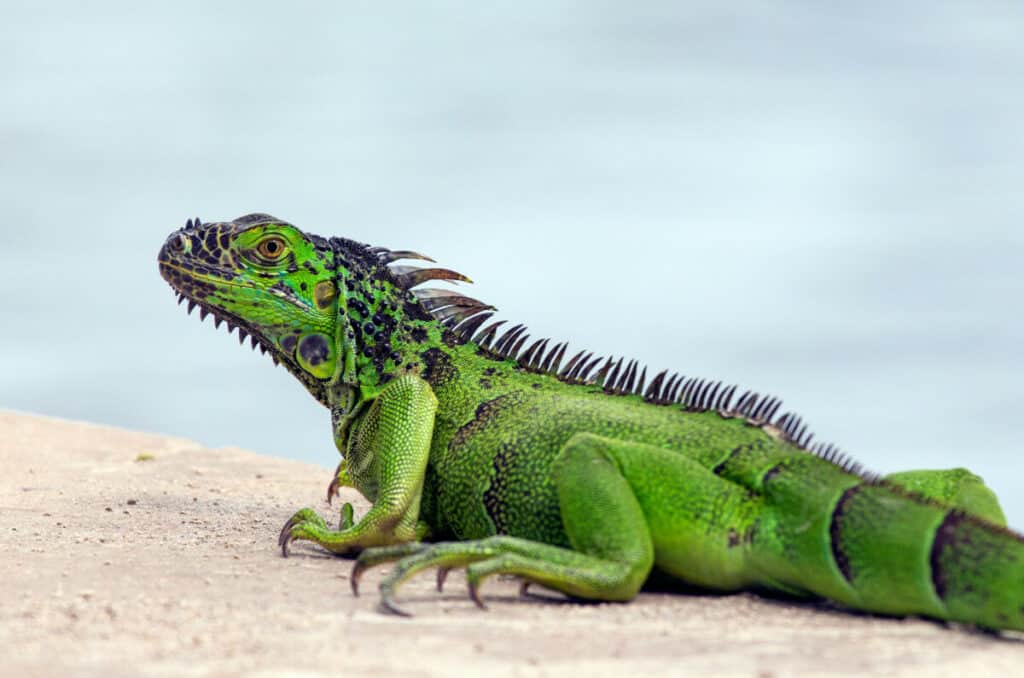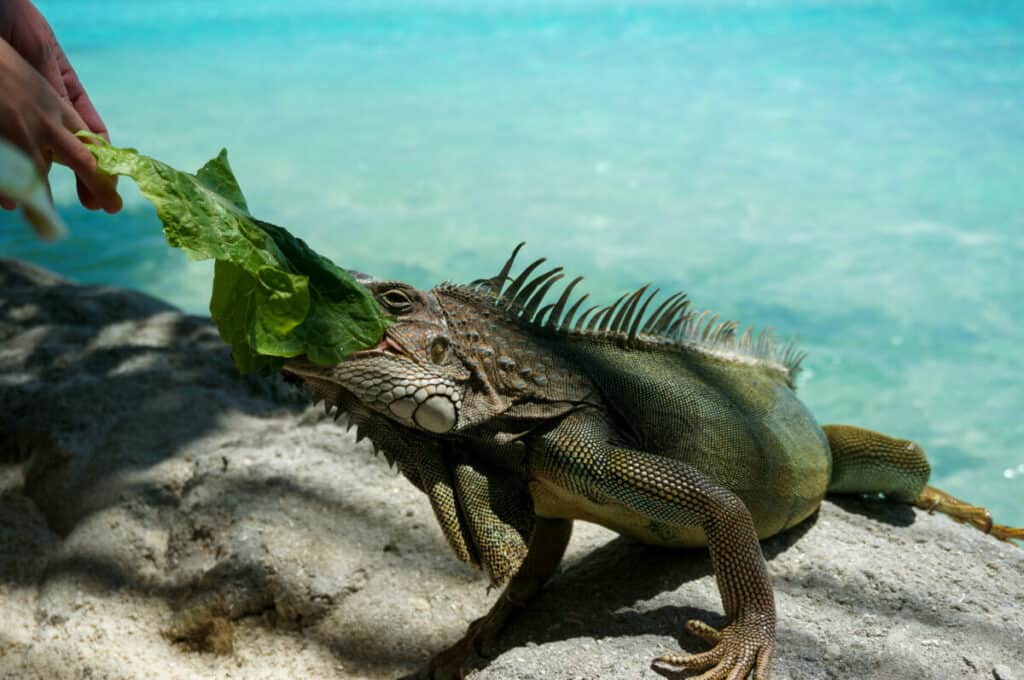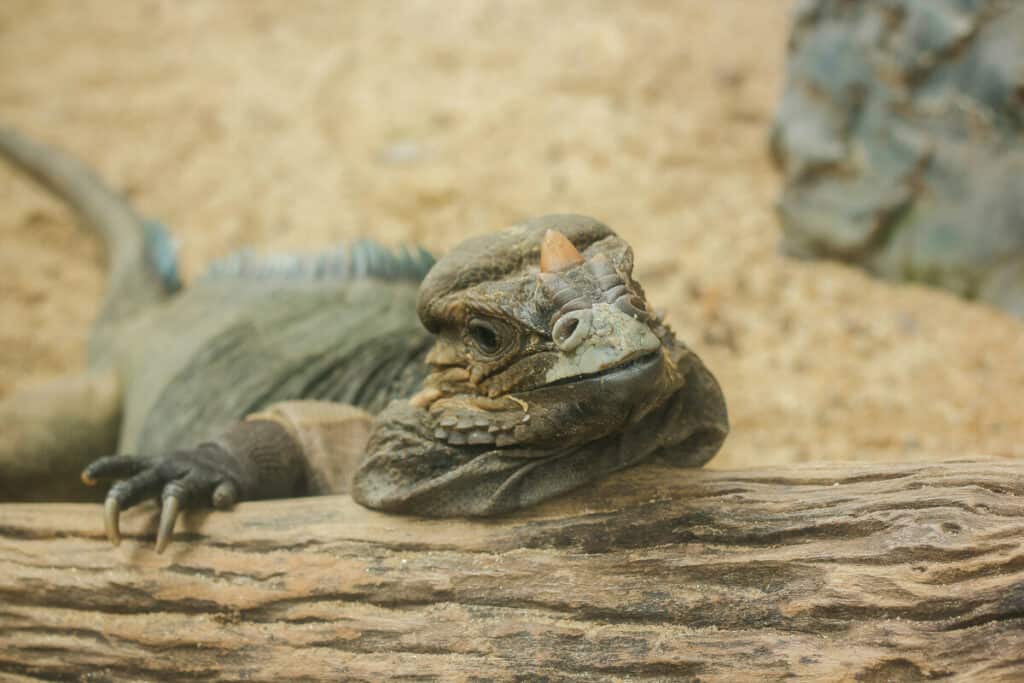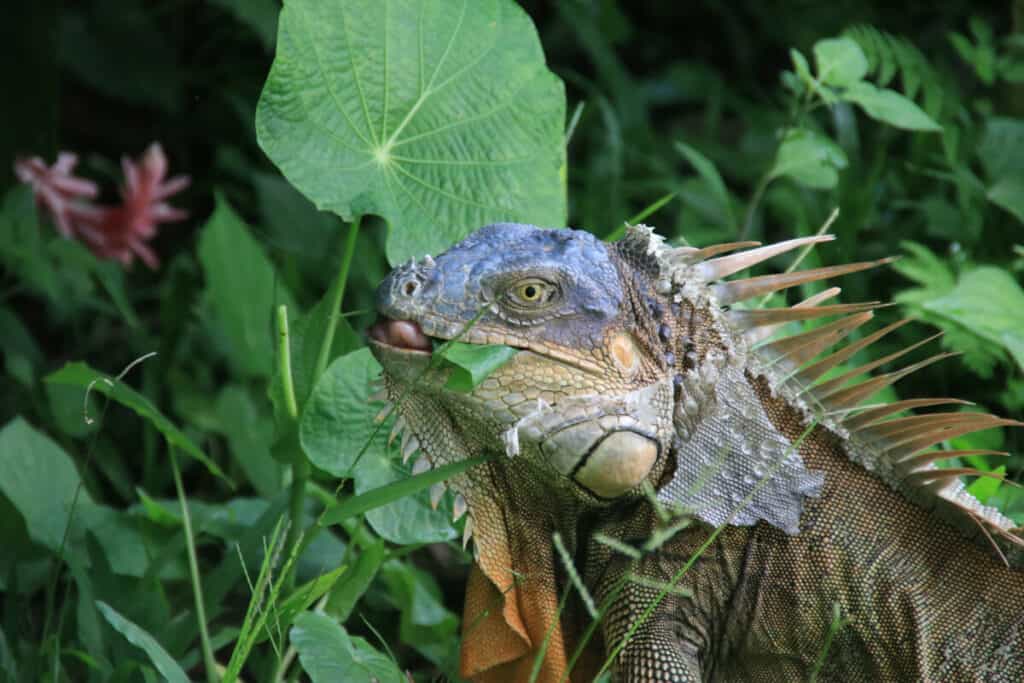
Iguanas are fascinating creatures and are often kept as pets by those that like reptiles. However, some people are unsure what their natural diet is like and what it should be comprised of. Many people do not want to feed their pets live prey. So, are iguanas herbivores?
Most iguanas are herbivores, so they eat plants, leaves, vines, fruits, and flowers. However, some species of iguana are omnivores because they also sometimes eat meat like mealworms and crickets. However, domesticated iguanas should not eat meat unless it is recommended by a veterinarian.
Iguanas can eat many things. Although there are many different species of iguana, information about what two of the most common species kept as pets (green and rhinoceros iguana) eat is below.
However, before you get too excited about finding a pet lizard that does not eat live prey, you should note that iguanas are not the best choice for beginners. They should only be kept by experienced keepers.
Are Green Iguanas Herbivores?
Green iguanas can be considered herbivores because they eat plants, flowers, vines, leaves, and fruit. They mainly eat leaves and vines, but they enjoy eating fruit and flowers as a special treat occasionally.
Though in the wild they might eat a few insects here and there, it is best to feed them a vegetarian diet. Of course, the best thing to do is to talk to your vet about the best diet for your iguana.
However, green iguanas are not called vegetarians, even though they eat things that human vegetarians eat (other than maybe vines). Instead, they are considered herbivores.
Can You Feed Pet Iguanas a Vegetarian Diet?
You can feed your pet iguana a vegetarian diet. In fact, that is their preferred diet, even though they are not technically considered vegetarians. A human vegetarian diet usually consists of fruit, vegetables, beans, grains, nuts, and seeds. However, many things that a human vegetarian eats is toxic to iguanas.
Iguanas need to be fed a diet of select leafy greens, vegetables, and a small amount of fruit. They should not be fed seeds, grains, or anything else that is not recommended for green iguanas.
What Do Green Iguanas Eat in the Wild

In the wild, green iguanas eat vines, leaves, fruit, plants, and flowers. They basically eat anything plant-like that they can reach from their natural environment. Iguanas often hang out in trees, where vines, flowers, leaves, and plants are abundant. They also spend time underwater, where different types of plants grow, when they need to avoid a predator.
Green iguanas are originally from warm, tropical areas in South America, Central America, and the Caribbean Islands. However, they now also can be found in Florida. In these warm climates, the types of food that green iguanas eat is abundant.
Green iguanas don’t eat meat, even when living in the wild. They might eat the occasional insect or egg but it is rare enough to simply think of them as having a herbivore diet.
Are Rhinoceros Iguanas Herbivores?
Rhinoceros iguanas are considered herbivores by many scientists. However, they are not technically herbivores. Instead, they are omnivores, so they eat meat and plants. In the wild, rhinoceros iguanas eat land crabs, snakes, small insects, dead birds, dead fish, leaves, fruit, flowers, and seeds. However, meat is a small minority of a rhinoceros iguana’s diet. (Source)
Instead, rhinoceros eat meat when an insect or animal (dead or alive) that they can eat is near them. They are opportunistic meat-eaters, they don’t typically go hunting for meat to eat. Instead, they make do and quite enjoy eating the plants naturally found in their habitat.
Rhinoceros iguanas are mainly omnivores because of how much they have to compete with other animals to get to a source of food. Many animals that are native to the areas that rhinoceros iguanas are from are also herbivores, which means that there is a lot of competition to get to plants so they can eat.
It is much easier for rhinoceros iguanas to simply be omnivores rather than herbivores as it expands their source of food that has less competition. But if you where to keep a rhinoceros iguana as a pet you would feed them vegetarian diet. You can read more about this in my rhinoceros iguana care guide!
This is one way that rhinoceros iguanas differ from green iguanas, even though many people think that all iguanas have the same diet. Green iguanas are exclusively herbivores except for a very rare insect, so they never eat meat, even when given the chance to do so. This means you have to take care of them in different ways, so you should always ask your vet what you should feed your pet iguana.
Rhinoceros Iguana Diet

The diet of a rhinoceros iguana is more extensive than the diet of a green iguana. Pet rhinoceros iguanas should eat fruits and vegetables, and they should be given vitamin and calcium supplements if your vet recommends them. Domesticated rhinoceros iguanas should not be fed bugs like crickets and mealworms unless recommended by the vet.
They should be getting all of the food and nutrients that they need from the fruits and vegetables you feed them, as they are no longer competing for food sources.
Here are some of the foods that you should feed your pet rhinoceros iguana:
- Chard
- Lettuce (different types)
- Parsley
- Mustard greens (small amounts)
- Peas
- Parsnips
- Okra
- Bell peppers
- Vegetables with low-starch levels
- Carrots
- Sweet potatoes
- Beets
- Squash
- Pumpkin
- Yellow crookneck
- Zucchini
- Butternut squash
- Pumpkin squash
- Delicata squash
- Peaches
- Pears
- Plums
- Apricots
- Cherries
- Apples
- Mango
- Papaya
- Pears
- Nectarines
- Kiwis
- Bananas
- Grapes
- Watermelon (seedless)
- Blackberries
- Strawberries
- Acai berries
- Raspberries
- Blueberries
- Cantaloupes
- Honeydew
- Hibiscus flowers
- Dandelion greens and flowers
- Borage leaves and flowers
- Calendula flowers
- Marigold flowers
- Chamomile
- Clover
- Cornflower
- Dahlia
- Dianthus
- Elderberry flowers and berries
- Geraniums
Rhinoceros iguanas can eat meat, but it is not necessary for your pet rhinoceros iguana to eat meat because you are giving them enough nutrient-filled food and they are not exploring large bodies of land, so they are not using as much energy as they do in the wild, where they sometimes eat meat.
If you do feed your rhinoceros iguana meat, only give it to them a few times every week and only if approved by your vet.
If your rhinoceros iguana’s veterinarian recommends you give your rhinoceros iguana meat, they might suggest.
- Crickets
- Mealworms
- Pinky mice
- Hard-boiled eggs
Picking The Right Foods For Your Iguana
When you purchase fruits and vegetables to feed to your rhinoceros iguana, make sure that it is organic, fresh in season, and free of all chemicals and pesticides. If your rhinoceros iguana eats food treated with pesticides, it can make them extremely sick.
Although rhinoceros iguanas enjoy eating flowers, they aren’t very nutritious. I know, surprising. Because they aren’t very nutritious, you should only give flowers to your iguana as a special treat or snack. You should not feed your rhinoceros iguana flowers every day, or they won’t get enough nutrients.
If you are feeding your rhinoceros iguana flower petals that have a vitamin or calcium supplement powder sprinkled on top, then you can feed them flowers more often.
Most of your rhinoceros iguana’s diet should be made up of leafy greens and vegetables. Before you feed your pet iguana, chop up the vegetables so it is easier for them to eat. You should feed your iguana vegetables every day, especially if you add vitamin or calcium supplement powder.
Make sure when you feed your rhinoceros iguana melons, fruits, or squash with seeds that the seeds are completely removed before they are given to your iguana. Fruits should only be given to rhinoceros iguanas a few times every week.
Here are some foods that you should avoid feeding your pet rhinoceros iguana:
* Of Course this is not a complete list but just some common foods often given to iguanas
- Broccoli
- Spinach
- Cabbages
- Corn
- Celery
- Brussels Sprouts
Some experts say that you shouldn’t feed different types of lettuce to your pet rhinoceros iguana often, so check and see what your vet recommends you do.
Rhinoceros iguanas don’t enjoy eating the same foods every day, so make sure you mix in some new, exciting foods into your iguana’s diet every few days. If you don’t they will get bored and may stop eating until they are extremely hungry.
What to Feed Your Green Iguana

Before you decide exactly what to feed your pet iguana, ask their veterinarian about what the best foods to give them are and how much to give your iguana of each food.
Avoid giving them iceberg lettuce and celery as they don’t contain a lot of nutrients and instead have a lot of water. Because celery is so stringy, it may be difficult for your pet iguana to eat it.
An Extensive List of Foods to give to Your Pet Iguana:
- Collard Greens
- Mustard Greens
- Turnip Greens
- Bok Choy
- Kale
- Parsely
- Alfalfa Hay
- Swiss Chard
- Romaine Lettuce
- Kohlrabi
- Escarole
- Dandelion (yellow flowers, before it turns to white seeds)
- Cactus
- Broccoli
- Squash
- Bell peppers
- Green beans
- Sprouts (not brussels sprouts)
- Sweet Potato
- Cucumber
- Asparagus
- Okra
- Parsnips
- Carrots
- Peat
- Cabbage
- Apples
- Pears
- Bananas
- Strawberries
- Raspberries
- Blackberries
- Blueberries
- Peaches
- Pears
- Plums
- Apricots
- Cherries
- Star fruit
- Watermelon
- Acai berries
- Okra
- Tomatoes
- Guava
- Kiwis
- Melons
- Figs
- Apricots
- Mangoes
- Geraniums
- Hibiscus
- Jasmine
- Orchids
- Roses
A Few Rules To Follow
If you have a lot of flowers in your garden and don’t use any pesticides or chemicals to help your flowers grow and thrive, you can feed approved flowers to your iguana, especially after the petals fall off.
Don’t go to the floral section of grocery stores, as they likely use chemicals to keep the flowers alive and grow them, and the floral shop employees likely don’t know exactly what was used where the flowers were grown or what chemicals they may have been treated with before they arrived at the store. That said, you don’t need to feed them flowers if you do not have access.
Fruits are great to feed to your pet iguana, but make sure you don’t feed too many fruits to them. They have a lot of sugar and water content, and fewer nutrients. Your pet iguana’s diet should mainly be leafy greens and nutrient-filled foods.
If you want to give your pet iguana food pellets, only give them a small amount every day and consult your veterinarian before doing so.
Feeding Frequency
You should be feeding your pet iguana once every day. If you are trying to get them to gain weight, feed them twice a day or more.
However, if you are trying to make your pet iguana lose weight because it is overweight, you should only be feeding them once every other day. Follow your iguana’s veterinarian’s advice when it comes to helping your pet iguana gain or loses weight for various reasons.
If your pet iguana refuses to eat, wait a few days before you start to panic, especially if you recently put them into a new enclosure or environment. When you first bring your pet iguana home, they may not want to eat because they are not used to you or the food you are giving to them. Wait a few days, then contact a veterinarian and make an appointment.
If your pet iguana doesn’t eat for a few days, contact the veterinarian and make an appointment. They might be sick and need treatment, or they may simply not like the food you are giving to them.
